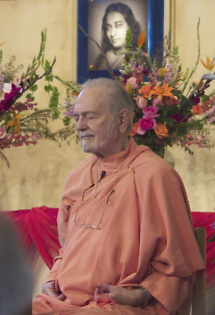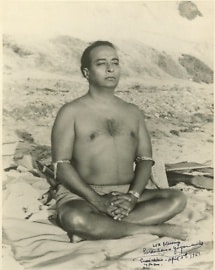Calmness is one of the eight manifestations of God that one can experience in meditation. Peace is also an aspect of God, though there is a difference between Peace and Calmness.
Paramhansa Yogananda explained the difference in this way:
Peace is an early meditative experience. Peace, like weightless waterfall, cleanses the mind of all anxiety and care, bestowing heavenly relief. Calmness is more dynamic and more powerful than Peace.
Calmness gives the devotee power to overcome all the obstacles in his life. Even in human affairs, the person who can remain calm under all circumstances is invincible.
The nature of delusion is to convey a sense of excitement. We confuse excitement with fulfillment, which leads to restlessness and tension and keeps us separate from God. Excitement exhausts our nervous system, creates a state of constant agitation, and prevents us from resting in the tranquility of the inner Self.
Experiencing Calmness
Swami Kriyananda explains:
The more you consciously withdraw your energy inwardly through meditation, the more you experience an enormous revitalization of energy and consciousness.
When you get into a deeper level of calmness, what you begin to feel is something very powerful indeed. It is an expansion of consciousness that begins to take you away from the ego.
It is almost overwhelming, much more than a simple state of peace might be. This profound calmness is the soil in which cosmic consciousness begins to blossom forth in your consciousness.
Calmness gives us an exceptionally clear mind and a very keen understanding that cannot come without deep inner calmness.
Paramhansa Yogananda said:
The calmer you grow, the more you will see the reflection of the universe within you.
How to Attain Calmness
Suggestions from Paramhansa Yogananda:
- Physical Relaxation
For complete relaxation of the whole body, first gently tense the entire body. Then relax and withdraw all energy from the body and remain relaxed, without the slightest physical motion. The complete absence of motion and tension from muscles and limbs is “relaxation.” Imagine that the body is jelly-like, without bones or muscles. When you can do this, you have attained perfect muscular relaxation.
- Mental Relaxation
The mind must manifest calmness. Where the worries and trials of everyday life are concerned, the mind must be like water, which does not retain any impression of the waves that play on its bosom.
No matter how busy you are, remember now and then to free your mind completely from worries and all duties. Dismiss disquietude from your mind. Remember, you were not made for worries; they were made by you. Do not allow them to torture you.
When you are beset by overwhelming mental trials or fretting, try to fall asleep. If you can do that, you will find upon awakening that mental tension is relieved and that worry has loosened its grip on you.
Tell yourself that even if you died, the earth would continue to follow its orbit, and business would be carried on as usual; hence, why worry? When you take yourself too seriously, death comes to mock you and remind you of the brevity of material life and its duties.
Mastery in mental relaxation comes with faithful practice. It can be attained by freeing the mind of all thoughts at will, and keeping the attention fixed on peace and contentment within.
- Daily Practice of Meditation
By regular practice of meditation you can divert the attention from worry to peace. When the energy is withdrawn from all the sensory nerves, the five sense-telephones are disconnected. No sensations can reach the brain and intelligence operators.
The mind gains freedom from thoughts that begin in sensations, as well as the associated thoughts of subconscious memory. This leaves the scientifically freed mind unhampered to march Godward.
Enter into absolute silence every morning and banish thoughts for several minutes each time. Sit quietly and meditate on the joy of Silence.
- Problem Solving
Whenever you want to solve a problem intuitively, first go into deep meditation or silence. Do not think of your problem during meditation but meditate until you feel a sense of calmness filling the inner recesses of your body and your breath becomes calm and quiet. Then ask God to direct your intuition so that you may know what to do.
- “Be calmly active, and actively calm. That is the way of the yogi.”
Apply the experiences of peace and poise received during concentration and meditation to your daily life. Maintain your equilibrium amidst trying circumstances, and stand unshaken by others’ violent emotions or by adverse events.
- Be Even-Minded
Never let your mind be seduced by restlessness through joking too much, too many distractions, and so on. Be deep. As soon as you succumb to restlessness, all the old troubles will begin to exert their pull on the mind once again: sex, wine, and money.
Be deep in everything you do. Even when laughing, don’t lose your inner calmness. Be joyful inside, but always inwardly a little withdrawn. Be centered in the joy within.
 Suggestions from Swami Kriyananda:
Suggestions from Swami Kriyananda:
- Live in the Present
In daily life, we can achieve calmness to a degree by keeping our awareness focused on the reality of the Spirit underlying all outward circumstances.
Calmness comes with the determination to live ever happily in the present moment, relinquishing the past, and not worrying about the future, but placing our lives firmly in God’s hands, and knowing that He is fully in command.
- Practice Non-Attachment
Calmness comes with non-attachment—with knowing that nothing in this world is truly ours.
Be calm in yourself, even-minded and cheerful through the gains and losses of life. Then, in calm, deep meditation feel the joy of the soul. Hold on to that joy through all activities. Don’t confine it, but try ever to expand it, until your little joy becomes the joy of God.
In our daily lives we can always try to be calm inside. Whatever you do, always feel that, in a sense, you are watching it happen—you are an interested but impartial observer. When you experience pain in this world, just say, “All right, this experience is happening and it is necessary. It will teach me lessons, but it won’t last. Let it teach me at least to be non-attached to it.”
Insert Moments of Stillness
During the day, especially when you are very busy, try to insert moments of stillness. Pause, and take a moment of stillness. Then continue with your activity. You will feel calmer and happier.
Regular deposits of calmness into your life’s bank account will help you create the habit of being calm in daily life and reinforce the benefit of meditation.
Affirmations for Calmness
By Paramhansa Yogananda:
The moment my mind is agitated, restless, or disturbed, I will retire to silence, discrimination, and concentration until calmness is restored.
My silence spreads like an expanding sphere, directionless, everywhere. My silence, like the ether, passes through everything, carrying the songs of earth, atoms, and stars into the halls of His infinite mansion.
By Swami Kriyananda:
I relax from outer involvement, into my inner haven of peace.
Though the winds of difficulties howl around me, I stand forever calmly at the center of life’s storms.
Guided Visualization for Calmness, with Nayaswami Diksha


16 Comments
One of the best posts. Very accurate,precise and truly motivating…
Compete in itself.
God bless us…
OV Singh Sisodia Lucknow India
Very inspiring.thank you Very much.
With divine love and friendship
Vidya
Priceless….!
Thanks for valuable divine message.
excellent and very helpful
many thanks I will practice in my daily life.
Thank you .with deep gratitude ,this comes at the perfect time. And thank for all the wonderful teachings supplied.
Namaste with deep heart felt appreciation.
Very motivating.
good Tips. Jai Gurudev
Let your service reach to God’s blessings;sure,God will bless you all.
Dear Nayaswami Diksha. Thank you for this very welcome Blessed article – which cleared some points for me on the very day I so needed – with much added wisdom and guidance as are all your articles. It is always a joy to read all the articles from all Ananda Blogs. Blessings and Joy to all of you Nayaswamis – to all who contribute – and to all readers
Thank you for sharing valuable and applicable information.
Dear Nayaswami Diksha, namaste and thank your for your beautiful article!
We find this article very helpful and have translated it into Traditional Chinese to post on our website. Hope you like our versions and you can find the articles here:
(This content is no longer available. -Editor)
Dear Cloud C,
I am glad that you found the article helpful and appreciate your efforts to translate it to Chinese.
I viewed the article on your website.
Thank you for sharing it with your students.
Blessings,
Nayaswami Diksha
Now is almost one yr and half, that I follow your letter every morning, I try your guidance, with not much success, but I do not give up, every morning I give half one hr, I set and try to meditate.
Thanks for the time you give to us.
Maria
Dear Maria,
To help you deepen your meditation practice, it is always good to review it.
Click here to review:
https://www.ananda.org/meditation/how-to-meditate/
You can also visit Ananda Meditation Support center:
https://www.ananda.org/meditation/meditation-support/
I wish you all the best.
Nayaswami Diksha
Oh Yeah! Jai Guru!